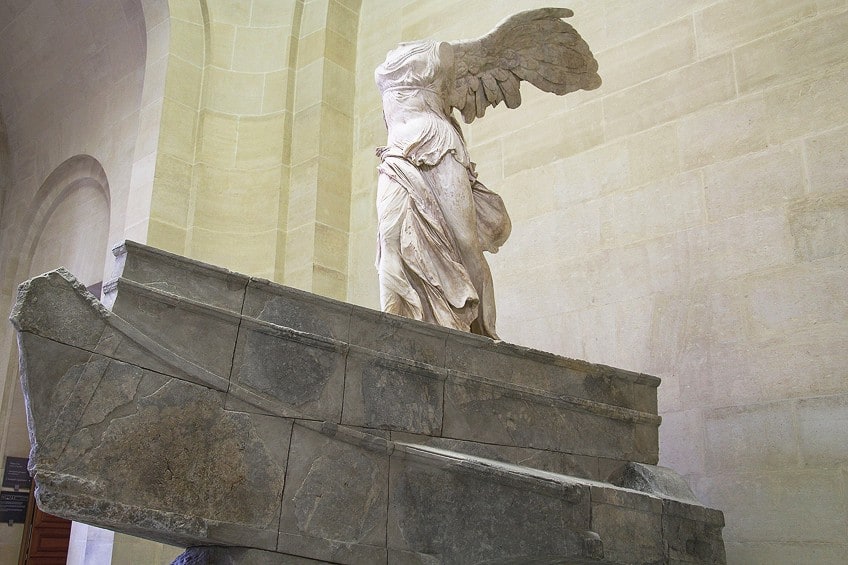Nike of Samothrace – Discover the Winged Victory of Samothrace
What is the Nike of Samothrace? Who made the Winged Victory of Samothrace? And what is the history of this famous artwork? The Nike of Samothrace is one of the most famous sculptures in art history with a fascinating provenance. In this article, we will introduce you to one of the best-known Hellenistic Greek statues in Paris, including details on its discovery, composition, and symbolism. Read on for more about this famous Greek statue!
Deep Dive: The Nike of Samothrace Statue
What is the Nike of Samothrace? The Nike of Samothrace statue is one of the most famous Hellenistic Greek statues that greet the visitors of the Louvre Museum in Paris. Measuring just over five meters tall in total and weighing around 29 tons, the elegant Winged Victory of Samothrace is located at the Musée du Louvre and has been part of its collection since 1863.
The famous statue has since remained one of the most iconic attractions of the Louvre and one of the best figural sculptures from Hellenistic Greece.
Nike of Samothrace (Winged Victory) (c. 190 BCE)
| Artist Name | Unknown artist speculated to be Pythocritos (Active c. 210 – 165 BCE) |
| Date | c. 190 BCE |
| Medium | Lartos marble (ship) and Parian marble (figure) |
| Dimensions (cm) | 512 (total height), 275 (white Paros marble), and 201 (gray, white-veined marble base) |
| Where It Is Housed | Musée du Louvre, Paris, France |
The world-renowned statue is one of the most treasured artifacts of the antiquity world. The art of ancient Greece during the Hellenistic period relied heavily on Greek mythology and is identified by the famous Nike statue, which we will dive into below. We will also examine the history of the statue, including the context of its creation, a brief analysis of the composition, and a few interesting facts about the sculpture!
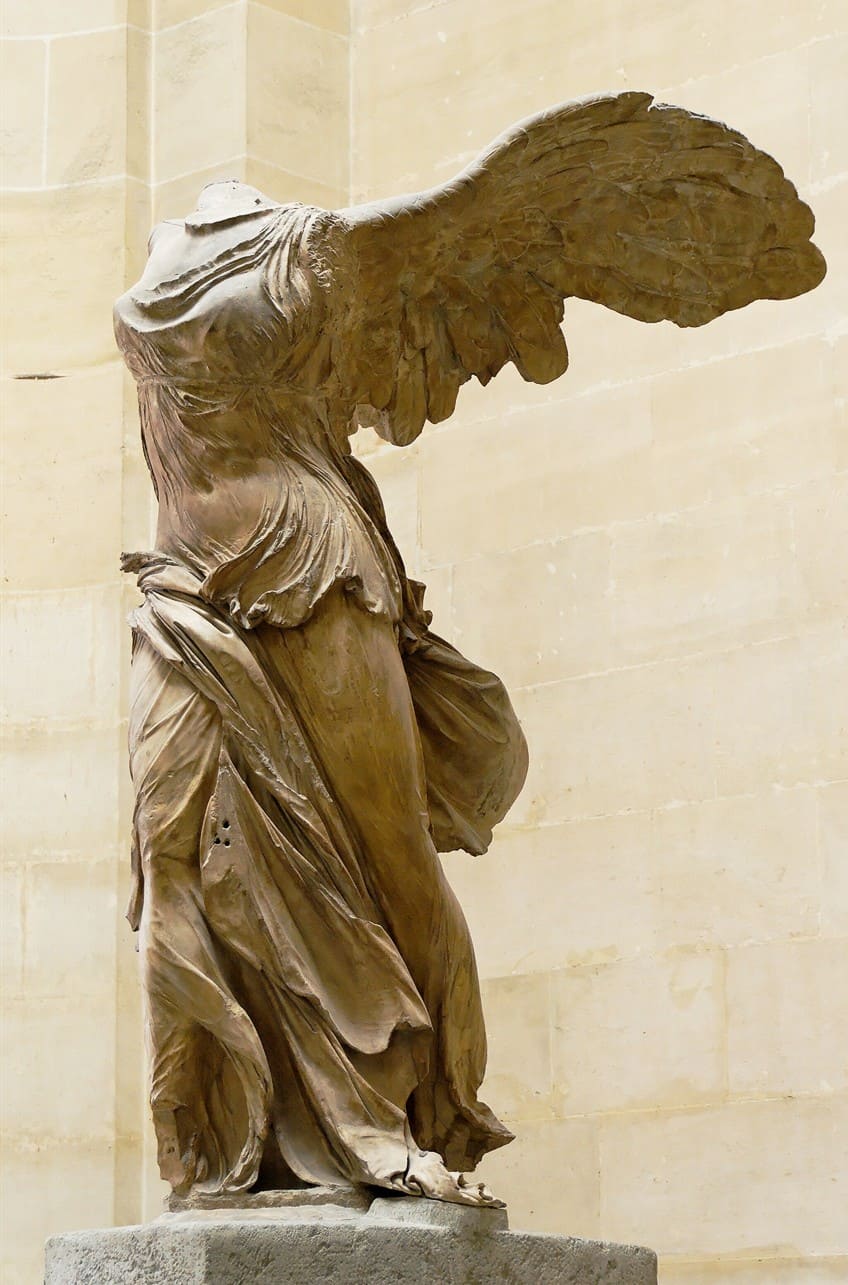
The Winged Victory of Samothrace: Creator and Context
Who made the Winged Victory of Samothrace? The famed Winged Victory of Samothrace was reportedly created by a sculptor called Pythokritos, who was the son of ancient Greek astronomer, Timocharis. The sculptor was identified by the 19th-century art historian Hermann Thiersch who was adamant that the 190 BCE statue was once part of a ship-shaped base. The statue, which dates to 190 BCE was created during the Hellenistic period in ancient Greece where the culture was shaped by the historical and cultural events of the time.
During this period, Greek culture was at the height of rapid development as it approached the beginning of the Roman Empire.
Hellenistic Greece can therefore be thought of as an age of enlightenment in antiquities, which was characterized by development across art, architecture, music, science, philosophy, and mathematics. This, of course, influenced the development of sculpture, which promoted the “Hellenization” of the world and the colonial influence of Greek culture.

Hellenistic art styles that were popular in Greece during the making of the Winged Victory of Samothrace included sculptural works that emphasized expression and naturalistic representations of the human figure. There was also a trend in the depiction of extreme emotion or what some may identify as a “dramatic Greek pose”, reflective of the state of the common folk as well as mythical subjects that were incredibly symbolic of the culture.
Discovery and Site
The statue was discovered on the northeastern Greek island of Samothrace situated in the Aegean sea. The island of Samothrace features a towering mountain that was home to an ancient temple or sanctuary built in honor of the Great Gods, also known as Kabeiroi. In 1863, amateur archaeologist and French diplomat Charles-François-Noël Champoiseau led an exploration project in March 1863 on the sanctuary and by April, he discovered a large, partially-clothed, white marble female statue.
Alongside the statue were fragments that appeared to belong to the sculpture, including remnants of wings and drapery.
The Goddess of Victory
Champoiseau would have been more than thrilled to find the statue since his mission was to locate any decent finds and ship them back to the Imperial Museum in Paris. The diplomat immediately concluded that the sculpture was a representation of the Greek goddess of victory, Nike. The goddess Nike was culturally significant among the people of Greece, especially during a time of heightened war. The image of Nike was an assurance of victory across multiple arenas of life, including the arts, sports, music, and even war.
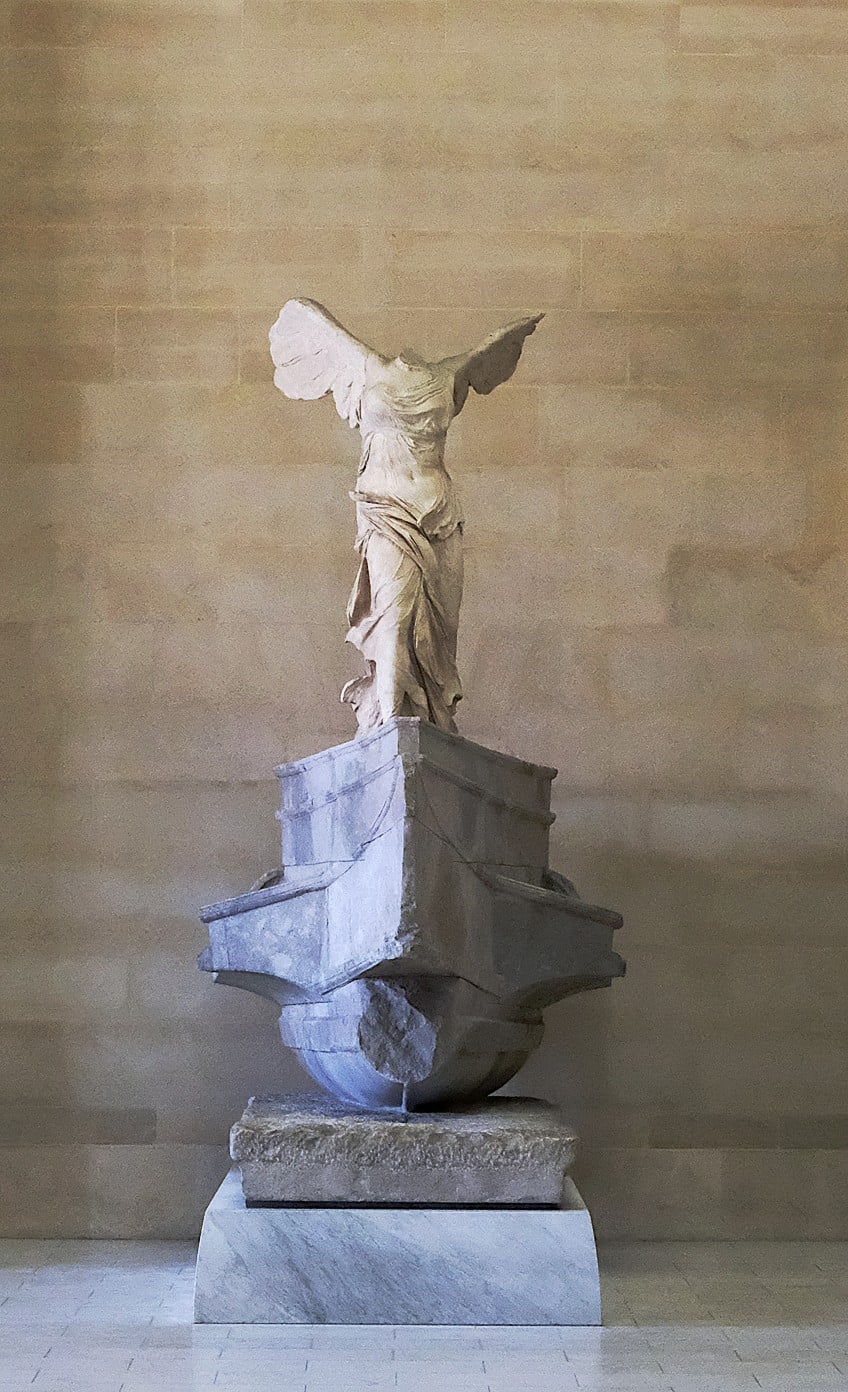
According to mythology, Nike was believed to be a facet of Athena who was made up of three defining characteristics: good council, skilled handcraft, and victory. It is believed that Nike broke away to be her own individual but still contested that Nike was more than likely her own goddess. Traditional representations of Nike include the goddess’ wings while others also exclude her wings. Another famous representation of Nike can be seen in a relief sculpture at the ruins of Ephesus on Mount Olympus.
From Concept to Deity
Similar to the idea of putting a face to a name and vice versa, the Greeks transformed concepts into deities as seen in Nike of Samothrace. Victory is one of the oldest concepts in ancient Greek history and the symbolism associated with her wings are significant to the mythological belief.
Nike’s wings were envisioned as large to enable her to fly across the world and spread the news of achievement and victory in war and sports. In essence, Nike is an angel or messenger who is also associated with a trumpet to announce herself.
In concept, as she flies, she delivers to the victor an insignia, which is represented in the form of a crown, ship trophy, palm branch, band, or weapon. When she arrives on Earth or the ground, she then partakes in a sacrificial ceremony initiated by the victor to express thanks to the great Gods.
Original Placement of the Winged Victory
Champoiseau sent the statue and its fragments back to France, which arrived in 1864 and took a full year to reach Toulon. An intriguing point of interest about the sculpture and its original site of discovery in the sanctuary was that the statue appeared to have been created for display in an open area, yet it was found in an enclosed space.

An archaeologist from Emory University shed light on the matter after describing the challenge in assessing where the sculpture was supposed to be installed. He points out that the Nike statue with her wings is naturally a flying figure and the contradiction was in the placement of the statue in an enclosed space, which would completely negate the purpose of the statue and the essence of victory if she were sheltered. He compared this to essentially placing Nike behind bars.
First Display at the Louvre
The Nike statue had undergone restoration and was first exhibited at the Louvre in 1866. The statue was mounted on a stone base with the main part of the torso on display. The sculpture’s wings and the right section of Nike’s leg were held in storage for the debut. The massive gray blocks, which are currently on exhibit today, were initially forgotten by Champoiseau since he mistook them for features of the sanctuary. Luckily for Champoiseau, in 1875, an architect from the Austrian archaeological mission examined the blocks and concluded that they resembled the prow of a ship.
The architect, Aloïs Hauser, also recognized the image of Nike standing on the prow of a ship from an ancient coin dating to 293 BCE.
The Cult of the Great Gods
The island of Samothrace had a relatively minor population size but was not shy of the occasional cult. Religious followers from other areas flocked to the island to engage in various religious ceremonies and practices hosted at the sanctuary where the Nike statue was discovered. The Hellenistic period saw a spike in the number of cult-like activities and an interest in religion. The Great Gods were venerated by a mysterious cult that required new members to participate in an initiation ritual. These elusive rites would remain a secret and only the member partaking in the initiation would know the details of the experience. One of the main cult guarantees was a promise of safety at sea and positive moral gain.

Aside from the secrecy of the cult and what it entailed, followers would also travel to great lengths to reach Samothrace regardless of their background or social class, which makes the island and the importance of the statue even more fascinating. Plutarch, a Roman scholar also documented the fact that Alexander the Great’s parents were members of the cult who were also initiated at Samothrace. The location of the Nike statue in the sanctuary was also of importance since it was located at one of the highest positions of the ceremonial site.
An Analysis of the Nike of Samothrace
Since the Nike of Samothrace statue was discovered in parts, its display and material are quite similar and can first be understood through the medium. While there is no conclusive evidence of the true identity of the artist or related artworks, one has to examine the statue through the material, composition in light of its context, and theories around where the sculpture was intended to stand. Below, we will look at the different elements of the sculpture to unpack its meaning in the broader realm of ancient Greek Hellenistic sculpture.
Material Composition
The Nike of Samothrace statue is positioned at the top of the stairs in the Musée du Louvre and can be materially understood in three sections. The marble used to make the figure was Parian marble, which is white and was recognized as the finest quality marble in antiquity. Parian marble was also used to build the Olympian Temple of Zeus as well as the Acropolis. Parian marble would have been sourced from the neighboring island of Paros, which was 1,082 kilometers away.
The second segment of the sculpture, the ship, was made from Lartos marble, believed to be sourced from the quarries of Lartos on the island of Rhodes. Rhodes was an ancient village located approximately 1, 034 kilometers away from Samothrace.
The Figure of Nike
The figure of Nike appears dressed in a thin fabric called a chitôn that is belted under her chest. Her dress is fixed to her shoulders by two thin straps with her lower body covered by a himation. Her garment appears to fall off her body but is held to her figure by the invisible wind that the statue alludes to. Despite her original feet missing, she is positioned with her right leg forward to support her weight. The depiction of Nike is intriguing since the artist captures a moment where the deity is about to land, which is a subliminal space to suspend the figure.
Her hands gesture the signal of victory as she lands on the ship. It is believed that Nike once held a naval standard (stylis) in her hand or perhaps a keepsake from the enemy’s ship.
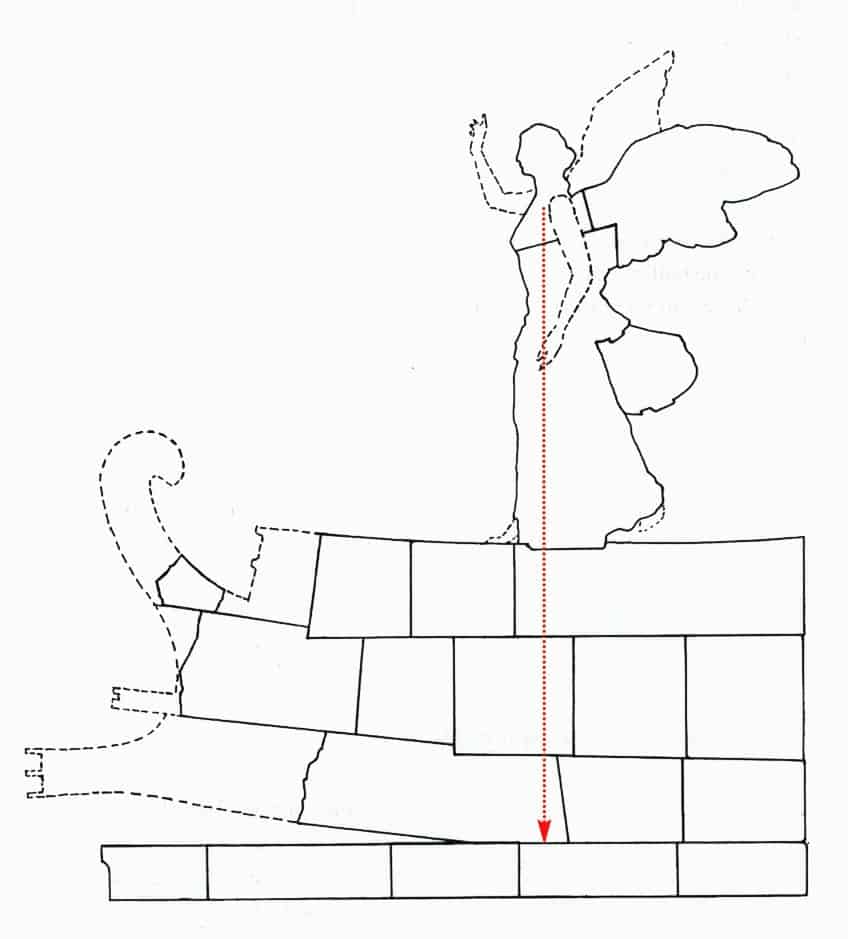
According to the statue’s design, viewers are meant to observe the work from three-quarters to the right so that the composition can be fully appreciated. The geometry in the figure is also captivating and emphasized by a vertical running from Nike’s neck to her right foot as well as an oblique angle that starts from her neck and runs diagonally across her left leg.
Invisible Forces and the Divine
The illusion of movement in the statue of Nike is evident in the focus on her drapery, which leaves the statue with a windswept look. The Samothrace Nike statue is one of the most extraordinary statues that differ from Near East and Greek statues. The Winged Nike demonstrates a very specific intention of highlighting not only the power of the wind but the invisible power of victory carried by the wind and simultaneously, by the landing of Nike on the naval vessel.
Nike also appears to fight against the strong gusts of wind. The invisible wind serves multiple roles. It first carries Nike in the air as that is her manner of travel and second, it fights against her body as she lands, creating an interesting conceptual contrast.
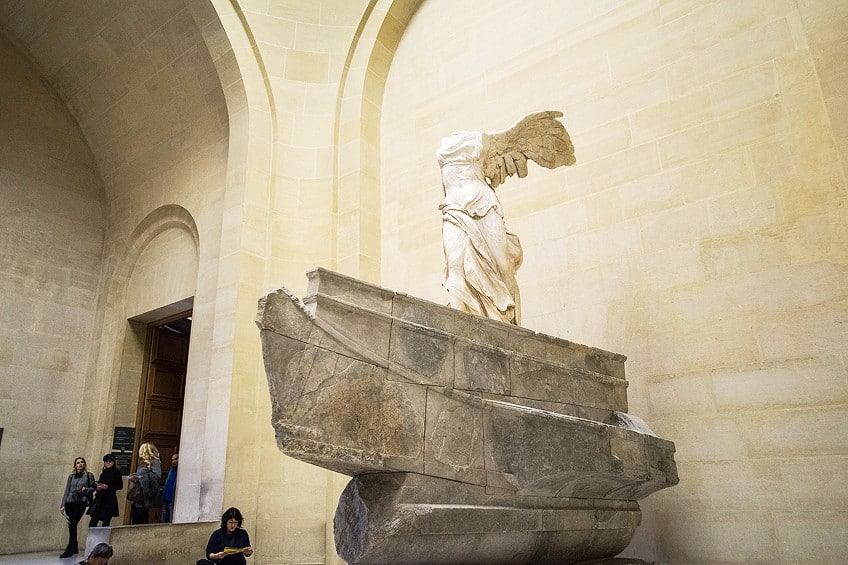
The dual nature of the invisible wind was a masterful artistic decision. It also reflects the fact that the sculptor was aware and deliberate about the role of the viewer who would be forced to imagine and accept the presence of the invisible, implied wind. The element of wind was also a common symbolic reference to grace, the divine, struggles, and fate, which enabled one to analyze the statue from varying dimensions. This is also what makes the statue’s allusion to the invisible force quite rare in the ancient world since similar artwork had only begun exploring such concepts 2,000 years later.
Composition and Style
The composition and style of the Nike of Samothrace are regarded as emotional with the intentional details of the many folds and details in her pose that indicate that the sculpture was meant to be viewed from multiple angles. Her pose is also romantic and stirs the emotions of the viewer in the direction of emulating Nike’s grace and identifying with the vulnerability of her body that faces the wind. There is a sense of pride in the statue as its design also indicates that it was meant for open space and demanded appreciation, just as those who struggle in war demand victory.
Nike’s divine presence along with her placement at the top of the staircase in the Louvre elevates her power and amplifies the feeling of being supported by the divine.
The Original Statue of Nike
The statue of Nike was, like many ancient sculptural works, once covered in a vivid display of paint. Studies of the statue indicate that there were originally traces of paint on the sculpture, which support the idea. Nike’s right wing was also re-sculpted and may not be entirely accurate to the original since many parts of the statue were missing.
Among other parts that were never found include her head, arms, and feet, but if one could imagine its existence, the statue may lose attachment to its iconic look and feel.
A few terracotta statues housed in the collection of the British Museum were discovered in Myrina, Anatolia, and are dated to a similar period when the Samothrace Nike statue was produced. Nike (c. 200-150 BCE) is one such terracotta statue that gives one insight into the possible appearance of the original Samothrace Nike statue. In 1950, archaeologists discovered the hand of Nike, which was found fingerless near the sanctuary, and soon after, connections were made with the Kunsthistorisches Museum that housed a few fingers belonging to the Nike statue.
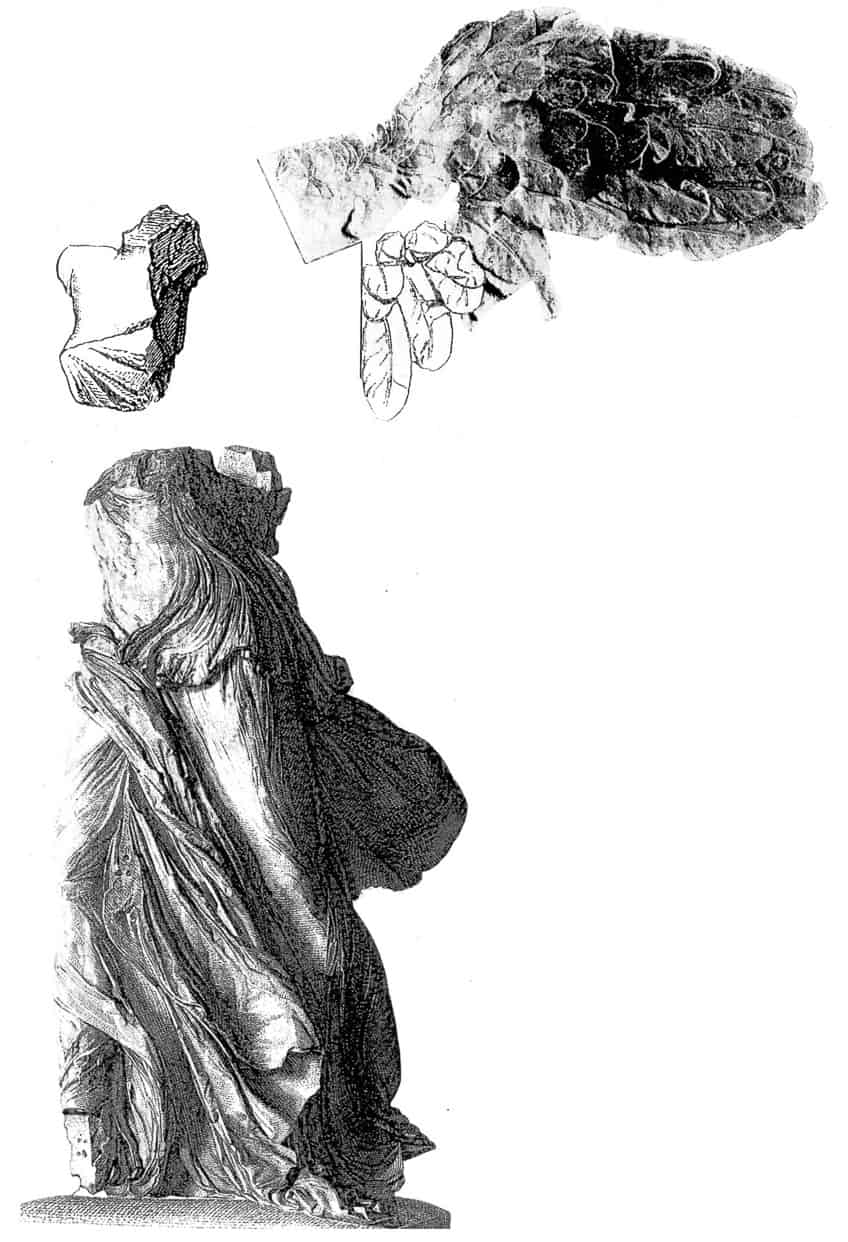
The missing fragments of the Nike statue were reconstructed and theorized that her right wing was most likely lifted upwards and raised higher while her right arm was positioned with her elbow bent, away from her body. Her left arm would have been sculpted against her body and her head possibly positioned straight ahead. Nike’s facial features from there on out are purely speculative.
Nike Statue Design Master
The Nike of Samothrace statue is also a sculpture crafted by a talented artist who seemed to have a knack for brainstorming innovative ways to solve creative problems. The wings on the Nike statue are composed of a very weighty marble and as such, required significant support. The sculptor seemed to resolve the difficult task by carving slots in the figure’s back where the wings would later be inserted to ensure that the wings do not break off due to the weight distribution. This clever solution was uncommon for the time and is definitely one of the many praiseworthy features of the original sculpture.
The sculptor also designed the wings so that they sloped in a downward position, resting against the figure and avoiding the need for external support. It was a genius move indeed!
Interesting Facts About the Winged Victory of Samothrace
Now that you have a comprehensive overview of the Nike statue and the significance of her making in ancient Greek history, we can now take a look at some of the most interesting facts about the statue!
A Hellenistic Marble Masterpiece
The Nike of Samothrace, as discussed in detail above, was sculpted with incredible detail in mind, which makes her one of the best Hellenistic marble masterpieces in ancient art history. From the way that her sculptor carved out a wet wind-blown fabric on her body to the deity’s form and the illusion of the invisible wind, the sculptor certainly created their best masterpiece.
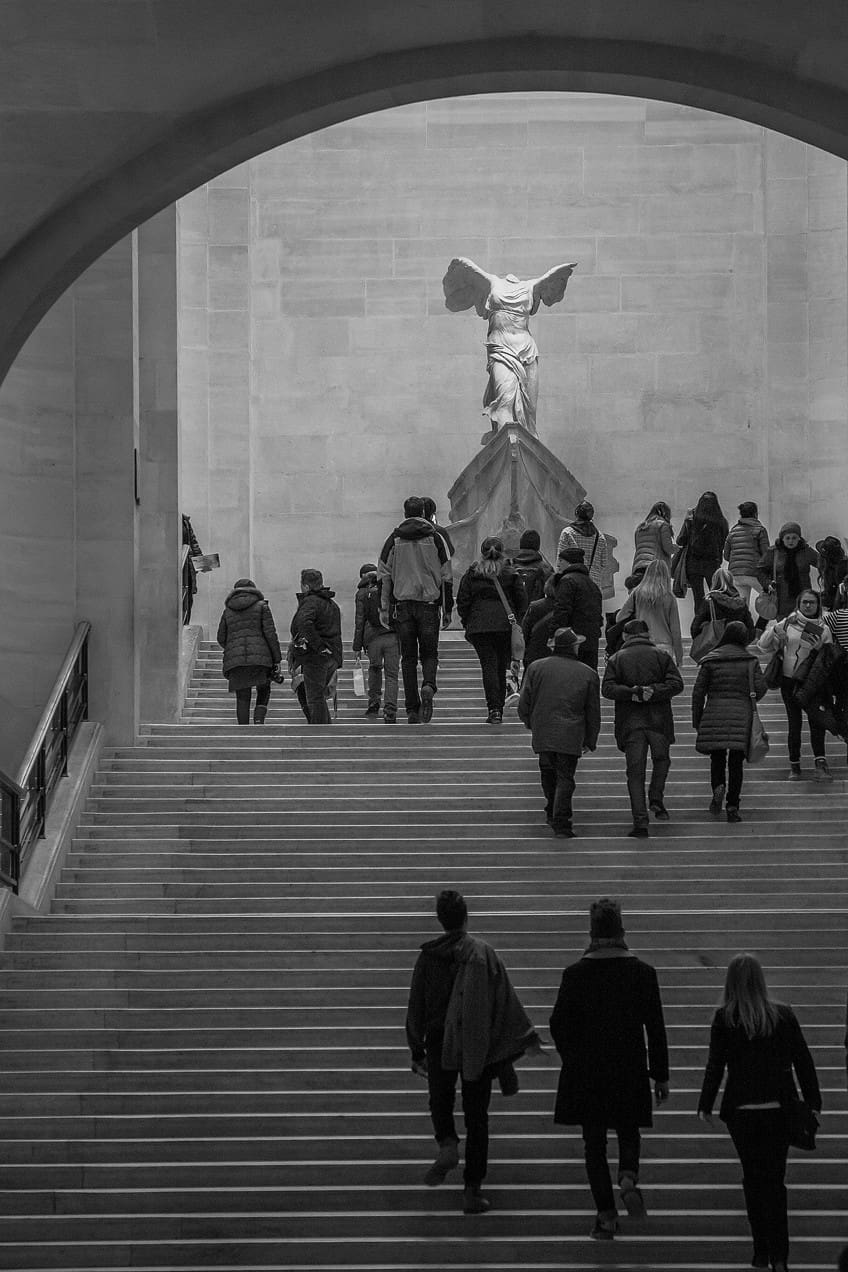
A Celebration of Naval Victory
Now that you are aware of the statue’s context among a highly secret cult group on Samothrace, you would also be happy to know that the statue was not entirely tied to a religious function. Similar to her role as a symbol of victory, the Nike statue was also a monument made to commemorate a naval battle and subsequent victory.
Although it is unclear which battle the statue was made for or the ship that was used to model the base of the statue, researchers agree on the fact that it must have been a battle that occurred at the start of the 2nd century BCE.
During this period, war was rife following Alexander the Great’s death, and the desire to control the Aegean region was immense. Hopefully, with time and emerging discoveries, more information about the naval battle that the Nike of Samothrace stood for will come to light.
Not Built in a Day
The ancient five-meter-tall statue was certainly not rebuilt in a day. The Nike of Samothrace was discovered in parts over a window of time and was only fully restored by the Louvre in 1884. Initially, the statue was introduced as a torso in the Louvre around 1866 without her wings. The statue regained its original pedestal in 1875 and has since remained in the iconic figure you see today, yet still missing her head and arms. In 1950, archaeologists uncovered Nike’s missing hand, which was exhibited with missing fingers. The positioning of her hand indicated that she was making a gesture of bestowing a helping hand.
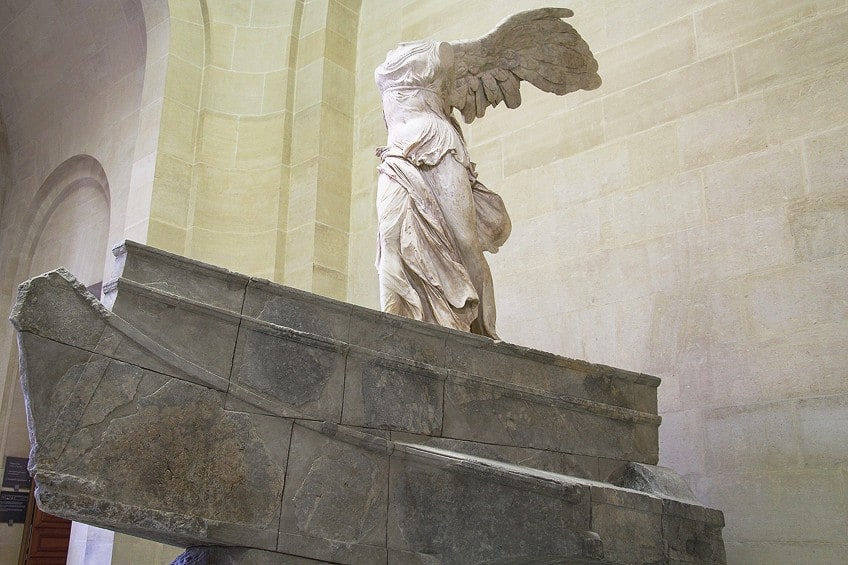
A Popular Attraction at the Louvre
Not only is the Winged Victory of Samothrace one of the most popular attractions at the Louvre but it is also carefully curated among many other legendary works of art, including the Mona Lisa (1503). The Louvre’s placement of the statue at the top of the staircase was an important decision since it resulted in the statue gaining a tremendous amount of attention, thus setting up the statue as one of the Louvre’s emblematic art pieces. The statue’s influence also reached the sculptor of the 1929 FIFA World Cup trophy, Abel Lafleur who titled the trophy the Jules Rimet trophy after modeling it in Nike’s image.
In 1971, what you may recognize today as the popular company Nike was also inspired by the popularity and image of the goddess, donning the famous swoosh logo.
Hypotheses About the Battle
Some of the prominent hypotheses surrounding the battle that inspired the sculpture or preceded it were pinpointed to either the Battle of Actium in 31 BCE or the Battle of Salamis in 306 BCE. The vessel that researchers believe Nike aligned with was called trihēmiolia and debuted among the Roman fleet around 304 BCE. This coincided with the time when Demetrius I of Macedon who took part in the Battle of Salamis, failed to conquer Rhodes.
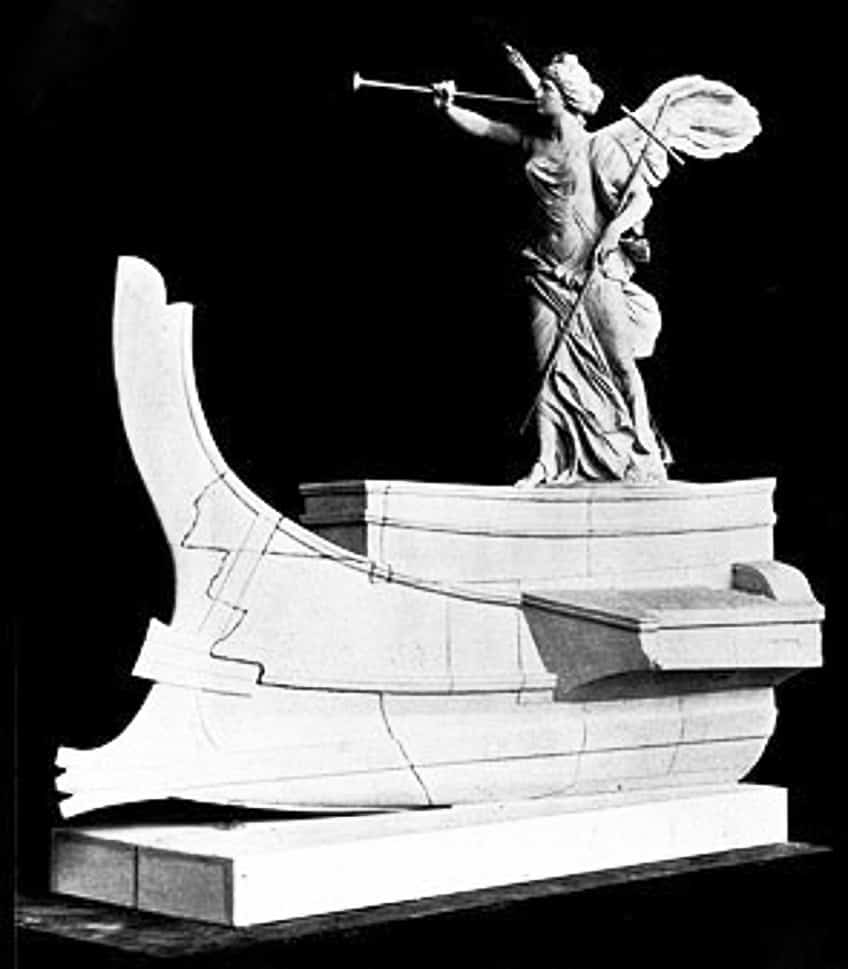
Since the marble for the statue was also quarried from Rhodes island it was theorized that the Rhodians commissioned a monument to commemorate their victory over the defeat of King Antiochus the Great around 188 BCE. During this period, the Roman Republic was also active in battle on the Eastern Mediterranean while the island of Samothrace was under the rulership of the Macedonians for the next two decades. History thus plays an important role in forming connections that broaden our insights into the origins of the statue. Historically, it was concluded that the Winged Victory of Samothrace belonged to a marine battle that occurred before the Treaty of Apamea and since the reign of the Macedonian king Philip V around 221 BCE.
The Winged Victory of Samothrace is perhaps one of the most interesting sculptures from Hellenistic Greek culture that spark dynamic conversations around the mysterious religion that operated quite close to the statue as well as the historical battles that were intertwined with the statue’s importance. We hope that this introduction and analysis of the Nike of Samothrace will encourage you to do some deep diving of your own, in the hope of uncovering more about the context of the statue.
Frequently Asked Questions
What Is the Nike of Samothrace?
The Nike of Samothrace refers to a Greek marble statue discovered in 1863 on the island of Samothrace. The sculpture represents the goddess Nike, who is also the allegory for victory. The sculpture can be seen at the pinnacle of the staircase in the Louvre Museum in Paris.
What Was the Winged Victory of Samothrace Statue Made Of?
The Winged Victory of Samothrace was made entirely out of marble. The sculpture contains two types of marble: Parian marble and gray Lartos marble, which were sourced from the neighboring islands of Samothrace.
Who Sculpted the Nike of Samothrace Sculpture?
Researchers believe that a man named Pythocritos, who was the son of the early Greek astronomer Timocharis, sculpted the Nike of Samothrace sculpture around 190 BCE. It was art historian Hermann Thiersch who made the connection.
Jordan Anthony is a Cape Town-based film photographer, curator, and arts writer. She holds a Bachelor of Art in Fine Arts from the University of the Witwatersrand, Johannesburg, where she explored themes like healing, identity, dreams, and intuitive creation in her Contemporary art practice. Jordan has collaborated with various local art institutions, including the KZNSA Gallery in Durban, the Turbine Art Fair, and the Wits Art Museum. Her photography focuses on abstract color manipulations, portraiture, candid shots, and urban landscapes. She’s intrigued by philosophy, memory, and esotericism, drawing inspiration from Surrealism, Fluxus, and ancient civilizations, as well as childhood influences and found objects. Jordan is working for artfilemagazine since 2022 and writes blog posts about art history and photography.
Learn more about Jordan Anthony and about us.
Cite this Article
Jordan, Anthony, “Nike of Samothrace – Discover the Winged Victory of Samothrace.” artfilemagazine – Your Online Art Source. April 17, 2023. URL: https://artfilemagazine.com/nike-of-samothrace/
Anthony, J. (2023, 17 April). Nike of Samothrace – Discover the Winged Victory of Samothrace. artfilemagazine – Your Online Art Source. https://artfilemagazine.com/nike-of-samothrace/
Anthony, Jordan. “Nike of Samothrace – Discover the Winged Victory of Samothrace.” artfilemagazine – Your Online Art Source, April 17, 2023. https://artfilemagazine.com/nike-of-samothrace/.


